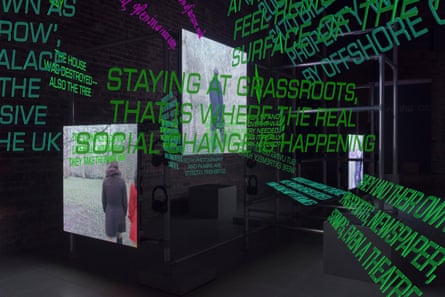Hito Steyerl is the very squeak of chic, as fashionable for her public lectures as for her essays, films and theories. Born in Munich in 1966, she is currently a professor of new media art in Berlin. Some people love her harshly ironic films, highly coloured, sharply cut but always intensely didactic (one is actually called A Fucking Didactic Educational .MOV File), while others prefer her performance talks on international surveillance, post-capitalist politics, the dissemination of images in our digital age – and so on and on. Naturally her work is available on the internet, but right now she has an exhibition at the Serpentine Sackler Gallery too.
It is by far the weakest show I have seen there.
The mise-en-scène looks intriguing enough – many screens glowing and twinkling in the ambient darkness. Some show blossoms so bright they are almost DayGlo, furling and unfurling and generally surging in these LED visions. The sense is of reality passed through some kind of filter – the human imagination, perhaps, or an AI algorithm. Certainly these are meant to be flowers of the future.
Small touch-screen panels throw up floating hypertext, including many heavy-handed “quotations” from books yet to be published, such as Flora of the Future Garden (2045) by Ricarda Deakin (get it?) and Botanical Gardens (2087) by Johanna Goethe (ditto?). There is much fanciful talk of California biologists creating the ideal plant to help curb global warming, of giant goldenrod appearing widely on London streets, its seeds carried into the city on the boots of refugees, or via packaging material, for which, presumably, read Amazon. All of which is somewhat crass and tiresome.
And the plants, meanwhile, look remarkably like what they originally were – good old rhododendron, tea rose and flowering cactus. In short, there has been a horticultural reversion. For a while I thought this might be deliberate, and witty; but so much of this show is on the level of a bad pun – Power Plants, Power Walks – that alas I doubt it.

Around the walls of the gallery, almost at roof height, runs some unfamiliar script. This is very beautiful: a specially designed font-cum-alphabet that borrows something from Roman lettering and something from hieroglyphics, but resembles a kind of brand new Garamond. There is no telling what it says, because the text is – of course – encrypted and cannot be read without a digital key that is, to all intents and purposes, mislaid. This is not just irksome but a practised affront. You are meant to be having a bad time. The Power Walks are brief films of Londoners walking through Kensington Gardens along the very paths by which you have reached the gallery. A man in a wheelchair speaks of his terrible difficulties with the government’s Independent Living Fund, and the effects of cuts on his daily existence. Another talks nostalgically about the 1970s, when squatters facing eviction from Freston Road, London W10, attempted to secede from the United Kingdom by setting up the Free Independent Republic of Frestonia.
Groups of women, filmed from behind, talk about the lives of modern slaves in the richest purlieus of Kensington and Chelsea – and of trying to find hidden women, so lost and imprisoned they cannot even describe where they are in clandestine phone calls.
Poorly shot, crudely edited and hard to hear: perhaps this is a deliberate aesthetic on Steyerl’s part, a way of emphasising the plight of the overlooked and unheard. Either way, this is an inadequate form of consciousness-raising; particularly since the films cannot be heard without one of the precious few headphones on offer. Primacy is given, instead, to a harmless soundtrack made by Steyerl in collaboration with the British rapper Kojey Radical.
Outside, you’re supposed to download an app to your smartphone, point it at the runes carved into concrete columns and see the gallery digitally transformed according to the rich-and-poor stats for the borough. Except that you cannot see this expensively choreographed data for the sunlight. The medium thwarts the message; that might be one interpretation, Steyerl warning us once more that technology may not be our friend. But in the end, it just feels like another feckless oversight.

Comments (…)
Sign in or create your Guardian account to join the discussion